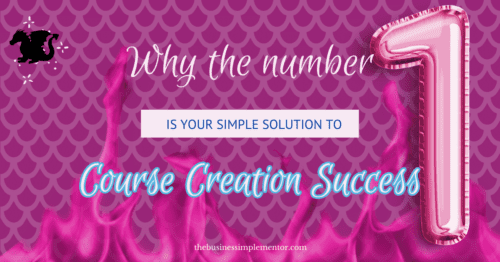Tell me if this sounds familiar. You begin to write a blog post, and before you know it, your “quick update” has turned into a rambling deep dive of some 3000 words that covers everything from where to find a graphic designer to how to design a business card.
All because you didn’t want to miss anything out. You wanted to provide EPIC value.
A blog post of 3000 words can generate a lot of fresh traffic if it is carefully crafted. Regrettably though, too often the topics in both blogs and lesson plans tend to become increasingly widespread and unfocused as each point is addressed.
Logo design leads to branding.
Branding leads to Tagline.
Taglines lead to ideal client avatars.
Avatars lead to…well, you get the idea.
Solve One Problem
It is important to give your audience the best information. You might think of adding too many details and your audience can get overwhelmed by it. It can be too much for you and them.
The key here is to know exactly what problem you want to solve. Then ask yourself if what you are adding directly solves that problem, or if it’s something separate you can create another time.
A few years ago I embarked on creating my first course. I was part of a dynamic team and we were all driven to give the best value possible. Our course consisted of 12 modules, one per month for a year. It is a huge course and it provides a wealth of information to the participants. But I feel it was too much. It was overloaded.
The challenge with an all-encompassing program of this size is that when your target audience is time-poor startups, a 12-month commitment is the first hurdle to overcome. It feels like a very long time to get a business up and running.
Don’t get me wrong, the reality is that this is not a stretch. Getting the foundations of your business right is so very important, and doing it at the start makes it so much easier than backtracking later. But when you tell someone that it will be 12 months before you start your business, it can feel way too soon, or way too long.
That is why I break my programs and courses down. Some women need a lot of time and space because they don’t have much to spare right now. Others might have a week off work and want to devote their entire week to deep diving and action-taking.
One Problem, One Solution
You need to focus, so your audience can too.
This is my daily mantra now.
The number ONE needs to feature in everything I do. One problem is solved with one solution created, one task, one day at a time.
Most people don’t need or want an all-inclusive answer. If your course helps your clients identify their ideal clients, then including information about choosing a domain name might seem relevant, when it’s just a distraction.
Worse, if you try to branch out too much, you run the risk of overwhelming your customer. Too much of that, and she’ll log out and never return—for this or any other course you create. Not because you’re a bad coach, but because she’ll be convinced she’s a bad student.
An additional issue with an overly broad curriculum is the compromised quality of knowledge. If your course has too much information, you end up with a shallow understanding of an array of topics.
Deep Dive Into a Solution
On the flip side, focusing on a single problem allows you to go deep and truly understand it. When you’re able to answer all angles of that one issue thoroughly, your students will have a much clearer understanding of the topic than if they were to try and tackle five different topics in one course.
By solving just one problem in your course, you can focus on what the student needs. And then you can use other content—blogs, podcasts, or even a future course—to tackle additional topics.
Keeping it simple is not a sign of laziness; it’s a sign of respect for your customers and their time.
By delving deeper and providing insights that can’t be found elsewhere, you create something that is truly unique. This can be done with extras such as:
- Case studies
- Worksheets
- Planning documents
- Checklists
- Multi-media content
These are the types of things that your audience will happily pay a premium for because they cannot find them elsewhere. When you focus your course on a single problem, you’ll have the leeway to create these and other resources.
Take a broader approach, though, and you’ll be forced to scrimp on the “extras.”
But make no mistake—there is still room for that all-inclusive, massive eCourse. One look at powerhouse coaches such as Marie Forleo and her massively popular B-School will tell you that.
Keep in mind, though, that if you decide to go ahead with a Course of this magnitude, you will (by necessity) have to:
- Expand the length of the course to accommodate all the extra information. Each week (or module) becomes its own “mini” course, focused on a single issue/solution.
- Increase the cost of the course. If your market will bear a high-ticket, multi-module course, then by all means you should produce one. But do keep in mind that the more information you provide, the higher the price point.
The Benefits of Keeping Your Course Simple
There are several benefits to keeping a course simple by providing one solution to one problem for women in business:
- Clarity: Focusing on one problem and one solution provides clarity for the course participants. They can easily understand the course content and know exactly what to expect from the course.
- Efficiency: A focused course allows participants to quickly learn and implement the solution without getting sidetracked by unnecessary information or distractions. This can lead to faster results and more efficient use of time.
- Tangible Results: Participants are more likely to see tangible results from a simple course that addresses one specific problem. This can help build confidence and motivation, and encourage participants to continue learning and improving.
- Repeatable: A simple course with a clear solution can be easily replicated for different problems or different target audiences. This makes it more scalable and can help you as a course creator reach a wider audience.
- Affordability: A focused course may be more affordable for participants than a comprehensive program that covers a wide range of topics. This can make it more accessible for women in business who may be on a limited budget.
Remember, too, that a large course is a much more difficult sell—and we’re not just talking about the price. There’s a bigger commitment on the part of the buyer as well, and that’s something she’s going to have to carefully consider before she takes the plunge. A smaller, single-problem course is easier to commit to and easier to complete for your audience.




